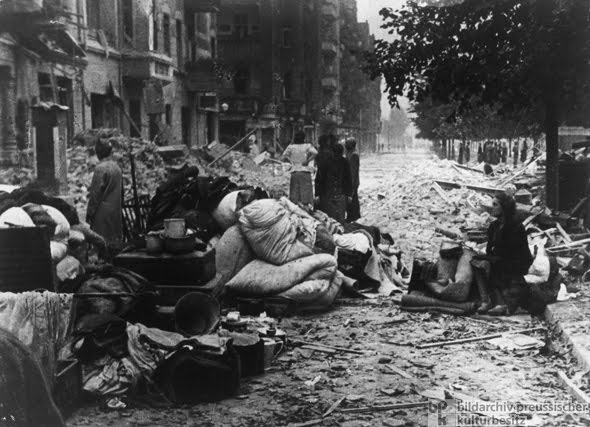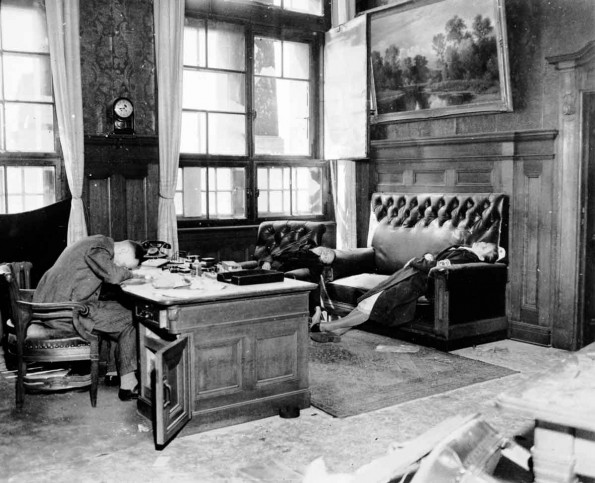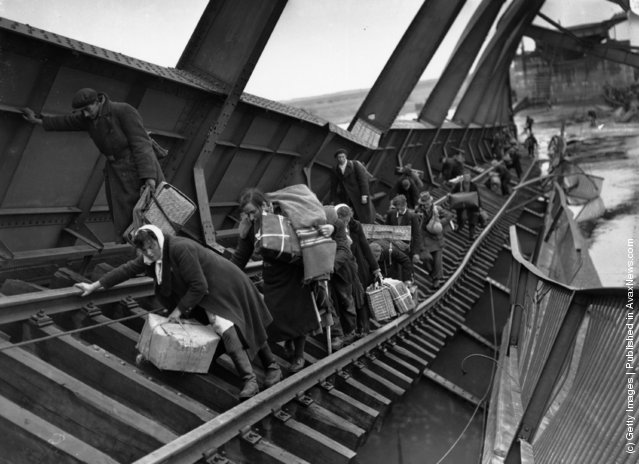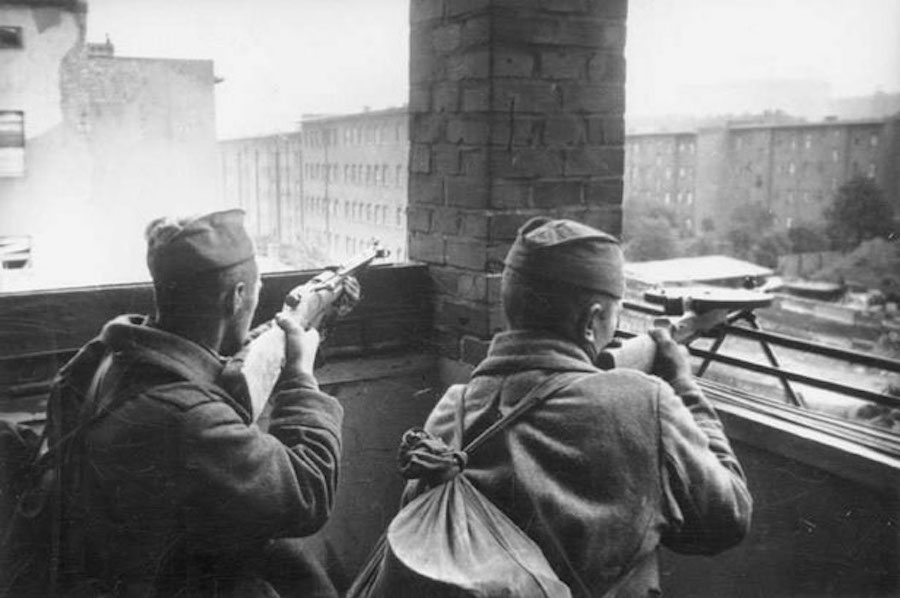Air Operations, CBI
CHINA- As Japanese forces begin withdrawing entirely from southern China, the 14th Air Force opens an offensive aimed at reducing their mobility by concentrating the bulk of its attacks against road, river, and rail targets. 2 341st Medium Bomb Group B-25s and 16 14th Air Force P-51s attack bridges Kiensiu and Taiku, locomotives near Shihkiachwang, and various military and transportation targets in the Loning area. Lt-Gen George E. Stratemeyer is selected by Gen Albert C. Wedemeyer to command Army Air Forces, China Theater, which will oversee the 10th and 14th air forces.
Air Operations, East Indies
- Though delayed by bad weather, 5th and 307th Heavy Bomb Group B-24s attack Tawau and support an amphibious landing by Australian Army forces at Tarakan Island.
- 42nd Medium Bomb Group B-25s attack airfields and other targets at Jesselton, Kudat, Sandakan, and Tarakan. Close support is provided by RAAF and XIII Fighter Command fighters and fighter-bombers.
Air Operations, Europe
US 8th AIR FORCENETHERLANDS:
- Inaugurating a humanitarian effort that will continue beyond the hostilities in Europe, 392 3rd Air Division B-17s drop 778 tons of food to needy Dutch civilians, in this case, in and around The Hageu and Rotterdam.
CZECHOSLOVAKIA:
- 9 9th Air Division A-26s attack a munitions factory at Stod.
- 9th Air Force fighter-bombers dive-bomb the German state alternate headquarters at Berchtesgaden.
ITALY:
- 12th Air Force B-25s are grounded by bad weather, but XXII TAC P-47s attack motor vehicles and horse-drawn conveyances ahead of advancing US 5th Army elements.
AUSTRIA:
- In the 15th Air Force's final bombing mission of the war, 27 B-17s brave bad weather to attack the railroad station and marshalling yard at Salzburg.
Air Operations, Formosa
- Weathered out of their primary target, V Bomber Command B-24s attack several small towns.
- B-25s attack Kagi and a sugar refinery at Heito.
Air Operations, Pacific
- The Mexican Expeditionary Air Force, equipped with P-47s, arrives at Manila.
- 8 tons of emergency food supplies are dropped to the civilian population in the Netherlands by US aircraft. The special flights will continue through the 8th with German cooperation.
Air Operations, Philippines
- 5th and 13th Air Force bombers and fighter-bombers attack targets on Luzon and Negros.
- 1st Marine Aircraft Wing PBJs, SBDs, and F4Us support the US X Corps on Mindanao.
Air Operations, Ryukyus
US Navy and Marine Corps aircraft support US 10th Army ground forces on Okinawa and attack airfields in the Sakishima Islands.
[Battle of the Atlantic
U-398 went on patrol in April and disappeared either in the North Sea or the North Atlantic for reasons unknown.
| Class | Type VIIC |
| CO | Oberleutnant zur See Wilhelm Kranz |
| Location | North Sea or N Atlantic |
| Cause | Unknown |
| Casualties | 43 |
| Survivors | None |
Burma
The British attacks in the Sittang Valley have now reached nearly to Pegu. The monsoon begins in southern Burma. As an alternative in case the land attacks have not made sufficient progress before this break in the weather, an amphibious operation, Operation DRACULA, to take Rangoon has been prepared and now goes into action, with parachute landings by 2 Gurkha (Nepalese) battalions at the mouth of the Irrawaddy on the east bank south of Rangoon. There is little Japanese opposition.
[CBI
CHINALt-Gen Albert C. Wedemeyer, commanding general of US forces in the China theater, names Lt-Gen George F. Stratemeyer as the commander of Army Air Forces, China theater, responsible for bringing the headquarters of both the 10th and 14th Air Forces under his command.
[Dutch East Indies
A naval attack force, commanded by Vice-Adm V. E. Barbey, lands a contingent of troops of the Australian 26th Bde Group and the Royal Australian Air Force on Tarakan Island, Borneo. The 17,000 Australians have the objective of seizing the 15-mile island, which contains major oil resources and an air base which the Allies wish to use for operations over Borneo. Resistance is fierce from the start, and the campaign to take the island will be one of Australia's bloodiest battles of the war.
[Eastern Front
Gen Hans Krebs is received by Gen Zhukov and asks for a truce. The Russian general demands unconditional surrender, and Krebs returns to the Bunker to report. Martin Bormann and Joseph Goebbels want to go on with the struggle, but Gen Helmuth Weidling, the Berlin garrison commander, decides on surrender. Goebbels has himself, his wife and his 6 children killed, Krebs commits suicide, Bormann escapes. After signing the surrender Weidling issues an order to the army and the people of Berlin for the immediate cessation of resistance of any kind. However, there are still a number of fanatical groups who hold out in the heart of the city. In the north the 2nd Belorussian Front spreads out along the Baltic coast and in Mecklenburg, taking Stralsund. Tito's forces, who enter Trieste on the previous day, make contact with the New Zealand 2nd Div on the Isonzo, near Monfalcone. The position of th 150,000 Germans in Alexander Löhr's Army Group E, left behind in Yugoslavia, is hopeless.
GERMANYThe Soviets capture the Reichstag, the 5,000 defenders suffering 50 percent losses. Gen Krebs, Chief of the General Staff, asks the Soviets for terms, but Stalin wants unconditional surrender and so the fighting goes on. However, the Germans are out of ammunition and they begin surrendering anyway.
YUGOSLAVIATito's partisans link up with the 2nd New Zealand Div at Montefalcone, thus cutting off the 150,000 troops of Army Group E in Croatia and Slovenia.
CZECHOSLOVAKIAThe citizens of Prague revolt against the German occupiers.[MORE]
[Germany, Home Front
It is announced on Hamburg radio that Hitler has died in Berlin, fighting for Germany, and that Adm Dönitz. is his successor.
The "Flensburg government" of Germany under Adm Dönitz is announced.
Hamburg radio announces that Hitler is dead and that Dönitz is the second Führer of the Reich. Dönitz himself broadcasts, announcing rather pathetically that 'it is my duty to save the German people from destruction by the Bolshevists.'
[Germany, Politics
Gen Krebs, chief of the General Staff of the Army High Command, initiates cease-fire negotiatons with the Soviets on behalf of the Nazi leadership in Berlin, Martin Bormann, Nazi Party Minister, and Josef Goebbels, Reichskommissar for Defense of the Capital. The Soviets demand unconditional surrender and the fighting in the captial and elsewhere continues.
Adm Dönitz, following the death of Hitler, assumes his duties as the new German head of state. He orders the utmost resistance in the East, where thousands of civilians are fleeing from the Red Army.
[Italy
The II Corps, US 5th Army, begins the liberation of the Piave valley and prepares to advance toward Austria across the Brenner Pass.
Gen Heinrich von Vietinghoff agrees to the surrender terms signed at Caserta. Tito's Partisans take Trieste. Possession of this city will become a point of dispute between Italy and Yugoslavia after the war. Italy will retain the city but Yugoslavia will take much of the disputed land nearby.
[Okinawa
With mountaineers' nets and ladders,units of the 77th Div try to scale the steep east wall of the Maeda Escarpment; some manage to reach the top, but are driven off by a furious night counterattack by the Japanese.
[Pacific
- The US submarine Trigger (SS-237) is reported as presumed lost in the Pacific Ocean area.
- The US submarine Bowfin (SS-287) sinks the Japanese gunboat Chowa Maru (2719t) southeast of Erimosaki, Hokkaido, Japan.
- The Japanese merchant ship Richo Go is sunk by mine off Woosung, China.
Ryukyu Islands
US carrier aircraft begin strikes throughout the area hitting Kuro and Kuchino Islands in the north of the chain.
[Western Front
In the British 2nd Army sector the units of the VIII Corps advance toward Lübeck and Hamburg. The US 9th Army ends its offensive with its 3 corps, the XIII, XIX and XVI, firmly dug in along the western banks of the Elbe. The US 1st Army is firmly established along the line of the Mulde. The 2 American armies have been forbidden to advance farther, into the zone designated for Soviet occupation.
In the US 7th Army sector, while the XV Corps proceeds with the mopping up of the Munich area, the VI Corps presses on toward Innsbruck and Imst. Field Marshal von Rundstedt is captured by US 141st Regt troops at Bad Tölz, south of Munich.
[Images from May 1, 1945
|
|
|
|
|
|
|
|







